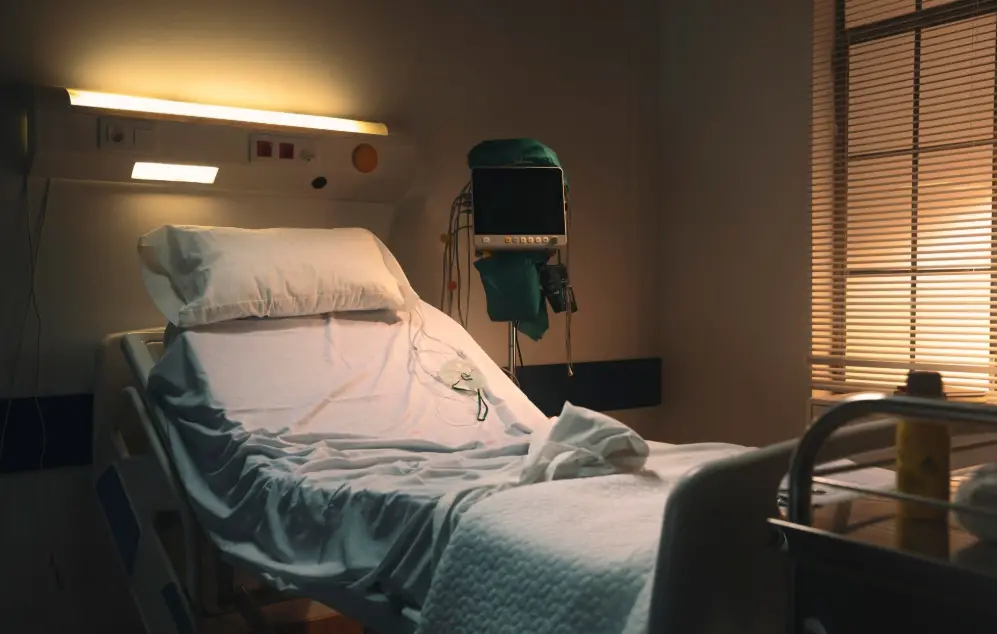Chapter 1: The Secret She Carried
Late one evening, the fluorescent lights of the emergency department hummed as paramedics wheeled in their latest arrival. The quiet lull that usually settled over City Hospital after dark was shattered by the sight of a frail twelve-year-old girl. Her limbs were slender and pale, but it was her abdomen that stunned everyone—a taut, balloon-like swell, gleaming under the hospital gown. Though she appeared pregnant, she was just a child.
Her name was Kira. Her mother’s tear-stained face spoke volumes: panic, guilt, confusion. Clutching her coat, she could barely whisper, “I thought it was just gas—bloating. I gave her tea. She said it hurt, but—” She broke down before finishing.
Kira lay curled on her side, arms wrapped protectively around her stomach. Her blue eyes blinked slowly, silent and still under the harsh lights. Without hesitation, Dr. Yelena Orlova—a seasoned physician with silver hair and unshakeable composure—rallied the team. IV lines were placed, blood was drawn, pain medication administered, yet nothing relieved Kira’s agony. Even the simple act of stretching her legs caused her to wince.
“It’s time for imaging,” Dr. Orlova declared.
An ultrasound revealed a massive volume of fluid pressing on Kira’s organs and lungs. There was no bleeding—only a dangerous accumulation. Whispers of tumor, infection, parasite floated through the room until a panel of specialists settled on the culprit: intestinal lymphangiectasia, a rare condition where dilated lymphatic vessels leak fluid into the abdomen.
Dr. Orlova faced the mother. “Your daughter has been quietly battling this for months, perhaps longer. Her body has been crying out for help.”
Her mother sank into a chair, trembling. “She never complained. Always smiling.”
“She protected you,” Dr. Orlova said gently. “Some children bear more than they should.”
Remarkably, Kira had survived. Surgeons performed a paracentesis, draining over three liters of fluid. Kira barely flinched, whispering before sedatives blurred her vision, “Mommy… I don’t want to die. I still haven’t finished watching my show…”
Hours later in recovery, wrapped in a wool blanket, Kira slept soundly with a bandaged bear by her side—a silent reflection of her own battle. When she awoke, she smiled weakly. “Will he get better too?” she asked.
The nurse’s tears showed the answer. “Only if it helps you heal faster.”
Thus began Kira’s arduous climb: medications, special nutrition, physical therapy. Each breath was hard-won, each movement a milestone. Through it all, Kira never cried. Not when needles pierced her skin, not during grueling therapy, not even when informed her life would never be quite the same.
“Her spirit is ancient,” one doctor murmured to another.
Within days, Kira became a legend on the pediatric ward—the girl who stared down death and still found reasons to smile. Nurses secretly left small gifts at her door. Children whispered tales of her bravery. Even a reserved janitor carved a wooden dove for her nightstand. And when a sudden fever and renewed swelling threatened her fragile recovery, the entire ward held its breath until she stirred, asking—once more—if she might have chocolate.
Watching her revival, Dr. Orlova let herself smile. “She’s going to make it.”
Chapter 2: The Light in Room 12
Room 12 transcended its sterile walls and beeping monitors to become Kira’s refuge. By day it grew brighter—flowers lined the windowsill—and by night, warmer with the soft glow of bedside lamps. News of Kira’s resilience spread: a child who braved the brink of death yet greeted the world each morning with a quiet “good morning,” gifting hand-drawn notes of courage to other patients.
Despite her fragility, Kira cared for others. She comforted Dima, a terrified leukemia patient who screamed at every needle. Rolling herself in a wheelchair, she revealed her scarred but triumphant belly and offered her bear as a companion. Dima calmed and accepted the gift, changing the ward’s energy from fear to hope.
But recovery wavered. A weekend fever spike and oxygen drop plunged Kira back into emergency care. Yet on the third dawn, she opened her eyes, raspy voice asking—for the second time—if she might have chocolate. The court of caregivers exhaled collectively. Dr. Orlova, standing in the doorway, whispered, “A miracle.”
Her mother, having sacrificed job and savings to stay bedside, often slept in chairs or washed in hospital sinks. Yet she never left. One night, Kira awoke to find her mother weeping. “Don’t worry, Mommy. We’ll survive. Everything else can wait.” Her words steadied her mother’s trembling heart.
After six grueling weeks, Kira was discharged—but the cost was steep. Their apartment gone, possessions sold for treatment costs, they moved into a single room in a dilapidated dormitory. Yet Kira proclaimed it “paradise” and “a place that smells like safety.” Cuddled with her mother, she understood that home was more than walls—it was their shared will to live.
Chapter 3: Stepping Back into the World
Outside the hospital, the world had marched on, unaware of Kira’s ordeal. In their cramped dorm, her mother cleaned late into the night while Kira insisted on returning to school—a place of teasing whispers about her distended abdomen. She endured cruel jokes in silence, her head bowed, until Lyosha—a shy boy whose mother worked at the hospital—sat beside her and praised her resilience. Their friendship blossomed, bringing Kira her first authentic smile since the ward.
She confided her dream: to become a doctor like Dr. Orlova. Lyosha teased he’d be her first patient, and she cheerfully agreed. Balancing school with lingering health struggles, Kira tracked her symptoms, learned her body’s cues, and attended rehabilitation sessions faithfully. Trainers marveled at her consistency: “She shows up every time.”
At a youth science fair, she wowed judges with a poster on lymphatic disorders titled “The Flood Within: A Silent Battle,” candidly revealing her own story. Her victory earned her a guest observer day at the city’s medical college—a revelation of belonging she savored in secret study sessions under a buzzing lamp.
When her mother’s cousin threatened their fragile housing, neighbors rallied: a retired nurse’s donation, textbooks from a mechanic, grocery vouchers from a shop owner. These modest gifts fueled Kira’s applications. Against the odds, she was accepted to medical college.
Chapter 4: Trials by Fire
Medical school was a crucible. Kira lived in a cold dorm, her mother scrimped to pay for her studies, yet she excelled—staying late in libraries, tutoring peers, and engaging eagerly in lectures. She befriended Nastya, a quiet classmate, after inviting her to sit together in the cafeteria. Their companionship deepened through long study sessions, dreams whispered in darkness, and mutual support.
Then a winter fire erupted in the dorm. Chaos reigned as students evacuated into freezing air. Hearing Nastya was still inside, Kira charged back through smoke and flame, locating her collapsed friend and hauling her to safety. The next three days found Kira hospitalized with smoke-inhalation injuries. When Nastya returned the favor—bringing notes, reading textbooks, and offering laughter—Kira realized their bond had become unbreakable.
Chapter 5: Pain as Purpose
By seventeen, Kira was known not only for surviving twice but for lending her unique insight to both peers and professors. She assisted in labs and spoke at student events on resilience and chronic illness. Yet another flare-up struck: abdominal swelling returned, threatening her second-year finals and weekend clinic work. Once again, she sought out specialists, underwent urgent surgery, and spent weeks recovering—this time supported by Nastya’s relentless care.
During convalescence, Kira discovered an online forum where a nine-year-old Alina described living with the same rare disease. Moved, Kira began “Kira’s Corner,” a blog for chronically ill teens. Her honest reflections—“Some days I want to scream. Some days I feel nothing. But I always return to hope.”—resonated. Thousands joined, including doctors and families. When Alina and her mother arrived at Kira’s modest apartment, Kira embraced the child she once was, reading stories and bandaging a tiny teddy bear, reaffirming her purpose: turning her pain into a light for others.
Chapter 6: A Life of Healing
At twenty-two, Kira graduated medical school to a standing ovation. She chose not to chase prestige but to return as a paramedic to City Hospital—where her journey had begun. On her first shift, she met an eleven-year-old girl with the same swelling and pain she knew so well. Holding the child’s hand, Kira whispered, “I was that girl. You will live.”
Today, her apartment overflows with letters, drawings, and messages from young patients and families. Her blog blossomed into a thriving community offering support and practical advice. Her book, Inside the Pain, is required reading in medical programs nationwide, its simple declaration—“Strength is not in the body; strength is in the soul”—echoed by students and practitioners alike.
One morning, Alina appeared at her door with her own child in tow, named in Kira’s honor. Tears fell as Kira realized the final gift: the cycle of saving had come full circle.
Though she never sought fame, Kira’s quiet revolution has transformed countless lives. She remains a beacon in the darkness for those who, like her, refuse to let suffering define them. In the once-bleak Room 12, she whispered farewell to her past and stepped fully into her calling—a healer forged by pain and sustained by love.

Adrian Hawthorne is a celebrated author and dedicated archivist who finds inspiration in the hidden stories of the past. Educated at Oxford, he now works at the National Archives, where preserving history fuels his evocative writing. Balancing archival precision with creative storytelling, Adrian founded the Hawthorne Institute of Literary Arts to mentor emerging writers and honor the timeless art of narrative.
